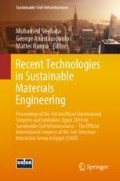Abstract
Despite its versatility in construction, concrete is known to have several limitations. It is weak in tension, poor in ductility and low in resistance to cracking. Its strength and durability suffer due to physical stresses, biogenic corrosion and chemical attacks. Cracks and fissures are typical signs in such situations. An attempt has been made to use a novel thermophilic hot spring bacteria to repair cracks and increase the durability in specimens of concrete/mortar. Mortar samples incorporating bacteria and cured in hot condition, showed a significant decrease in sulphate and water absorption capacities and a significant increase in compressive strength. Ultrasonic velocity test conducted on such samples confirmed more compactness in the sample. The bacteria incorporated concrete showed better performance in cracks repairing compared to the normal cement-sand mixture. The results clearly showed that remediation for cracks and durability of concrete structures can be enhanced with the addition of bacteria optimised at a cell concentration of 105 cells/ml water.
Access this chapter
Tax calculation will be finalised at checkout
Purchases are for personal use only
References
Gautam, D., et al.: Common structural and construction deficiencies of Nepalese. Innov. Infrastruct. Solut. J. (2016). https://doi.org/10.1007/s41062-016-0001-3
Ramachandran, S.K., Ramakrishnan, V., Bang, S.S.: Remeditation of concrete using microorganisms. ACI Mater. J. 98, 3–9 (2001)
Mehta, P.K.: Advancement in concrete technology. Concr. Int. 21(6), 69–75 (1999)
Ramachandran, V.S.: Concrete Admixtures Handbook: Properties, Science and Technology, p. 629. Noyes Publications, New Jersey (1984)
Diercks, M., Sand, W., Bock, E.: Microbial corrosion of concrete, cellular and molecular life science, 514–516 (2005)
Glassgold, I.L.: Shortcrete durability: an evaluation. Concr. Int. Des. Constr. 11(8), 78–85 (1989)
Hilsdorf, H.K.: Durability of concrete – a measurable quantity? IABSE Rep. 57(1), 111–123 (1989)
Norman, M.P.L., Beaudoin, J.J.: Mechanical properties of high performance cement binders reinforced with wollastonite micro-fibres. Cem. Concr. Res. 22981–22989 (1992)
Ramakrishnan, V., Panchalan, R.K., Bang, S.S.: Bacterial concrete. In: Proceedings SPIE, vol. 4234, p. 168 (2001)
Ghosh, P., Mandal, S., Chattopadhyay, B.D., Pal, S.: Use of microorganisms to improve the strength of cement mortar. Cem. Concr. Res. 35(10), 1980–1983 (2005)
Ghosh, P., Mandal, S., Chattopadhyay, B.D.: Effect of addition of microorganism on the strength of concrete. The Indian Concr. J. 80(4), 45–48 (2006)
Sarkar, M., et al.: Development of an improved E. coli bacterial strain for green and sustainable concrete technology. RSC Adv. 5(41), 32175–32182 (2015)
Sarkar, M., et al.: Autonomous bioremediation of a microbial protein (bioremediase) in Pozzolana cementitious composite. J. Mater. Sci. 49(13), 4461–4468 (2016)
Specification for 43-grade ordinary portland cement, IS 8112: Bureau of Indian Standard, New Delhi (1999)
Specification for Ennor sand, IS 650: Bureau of Indian Standard, New Delhi (1991)
Standard test method for pulse velocity through concrete, ASTM C597-02
Author information
Authors and Affiliations
Corresponding author
Editor information
Editors and Affiliations
Rights and permissions
Copyright information
© 2020 Springer Nature Switzerland AG
About this paper
Cite this paper
Mandal, S., Chattopadhyay, B.D. (2020). Use of Hot Spring Bacteria for Remediation of Cracks in Concrete. In: Shehata, M., Anastasopoulos, G., Norma, M. (eds) Recent Technologies in Sustainable Materials Engineering. GeoMEast 2019. Sustainable Civil Infrastructures. Springer, Cham. https://doi.org/10.1007/978-3-030-34249-4_6
Download citation
DOI: https://doi.org/10.1007/978-3-030-34249-4_6
Published:
Publisher Name: Springer, Cham
Print ISBN: 978-3-030-34248-7
Online ISBN: 978-3-030-34249-4
eBook Packages: Earth and Environmental ScienceEarth and Environmental Science (R0)

